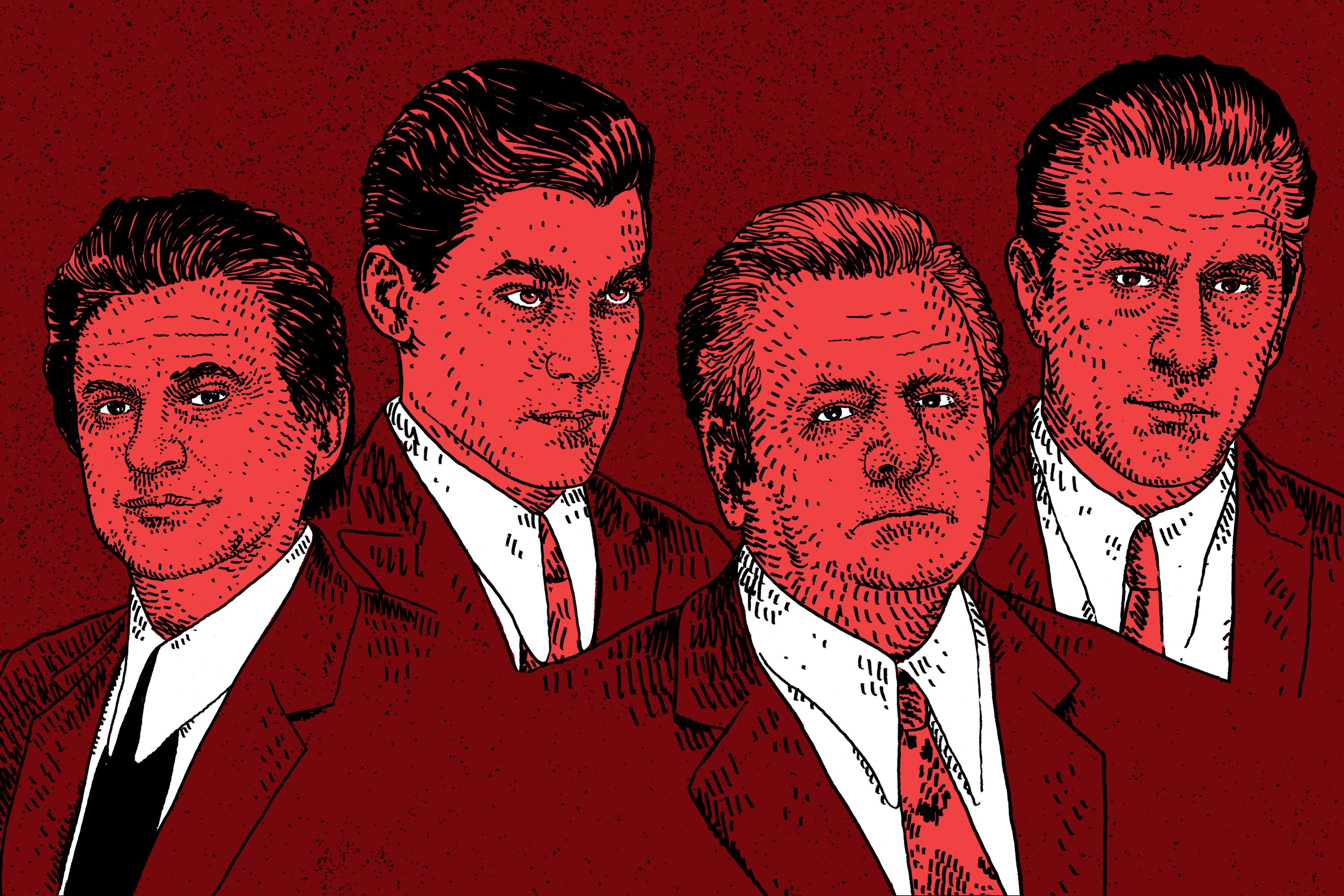How ‘Goodfellas’ Serves As the Bridge Between ‘The Godfather’ and ‘The Sopranos’
If it’s true that every great work of art ends one genre and founds another, then u003cemu003eGoodfellasu003c/emu003e could be seen as the culmination of the tradition represented by u003cemu003eThe Godfatheru003c/emu003e and as the vital link between the New Hollywood cinema of the ’70s and what we now think of as the golden age of TV
Ahead of Goodfellas turning 30 on Saturday, The Ringer looks back on the moments that define the movie in all of its complex, violent, darkly comedic glory.
The world, as Fredo Corleone knew it, has never been an easy place for middle children. Martin Scorsese’s Goodfellas opened 30 years ago this week, on September 19, 1990. It came out between The Godfather, which opened in March 1972, and The Sopranos, which premiered in January 1999. And if you imagine Goodfellas as the second installment in the great informal American mob trilogy made up of these works, then it’s clear that Scorsese’s madcap gangster epic is the hardest to talk about on its own, even as it might be the greatest artistic achievement of the three. It’s possible to talk about The Godfather and The Sopranos without mentioning Goodfellas, but any conversation about Goodfellas inevitably involves a lot of discussion of one or both of the other two works. Even if the upshot is to argue that Goodfellas is better than The Godfather, as Roger Ebert thought it was, or that it inspired The Sopranos, as David Chase acknowledges it did, its counterparts seem to keep it under a kind of reverential shadow.
In part, this is because its importance is harder to quantify. The Godfather revolutionized the movies. The Sopranos revolutionized TV. Scorsese’s film, the sprawling story of Henry Hill, a mid-shelf, midcentury mobster played by Ray Liotta, and his cronies in the not-quite-big-time Brooklyn underworld, didn’t revolutionize anything. The movie didn’t launch an array of imitators (at least, not imitators that weren’t already imitating The Godfather) or transform an industry. It contained its share of iconic moments—“Now go home and get your fuckin’ shinebox”; “You think I’m funny?”—but none on the “May the Force Be With You” god-tier rung of half a dozen moments from The Godfather, or on the slow-burn cultural-obsession level of the gradually unfolding plots of The Sopranos. (The ending of Goodfellas, for instance, didn’t provoke a national nervous breakdown.) Goodfellas didn’t do any of that stuff. It was only a perfect movie.
The partially eclipsed condition of what might be Scorsese’s best film isn’t really fair. In one sense, though, it’s understandable. Goodfellas is far more than a transitional film, but it does link the past and the future in some important ways. If it’s true that every great work of art ends one genre and founds another, then Goodfellas could be seen as the culmination of the tradition represented by The Godfather and as the vital link between the New Hollywood cinema of the ’70s and what we now think of as the golden age of TV. It took the central tension of the old mob-movie genre—the tension between our emotional identification with the characters and our moral judgment of their actions—to a giddy new place that looked ahead not just to Tony Soprano but to Walter White, Don Draper, and the other prestige antiheroes of 21st-century TV.
Why does a person become a gangster, and how do we, the audience, feel about the choice? This has been a driving question for mob movies since Scarface meant James Cagney, not Al Pacino: How, filmmakers ask, can we be made to invest emotionally in characters who behave in ways (murdering, lying, cheating, stealing) we would find terrifying, even evil, in real life? This is not a new tension in art—Don Giovanni was not exactly a Presbyterian—but in a genre obsessed with the codes and customs of people who reject the usual norms of society, it can be a powerful line of inquiry into the moral status of art itself.
If I can enjoy watching someone doing evil deeds on screen, the gangster movie asks, if I can root for that person despite knowing on another level that what he’s doing is wrong, then what kind of moral judgment falls on me? What kind of moral judgment falls on the artistic medium that coaxed me into this position? (That this is a problem not just for crime movies but for more or less the whole gamut of film genres ranging from war movies to superhero epics—“Why do I like watching someone shoot/stab/rob/lightsaber/retractable-hand-claw someone?”—is maybe one reason the mob movie, as a major venue for exploring the question, seems to have such lasting importance for film.)
The Godfather approaches this tension by imbuing the world of organized crime with a dark grandeur of feudal morality. In the Corleones’ universe, honor and family tradition are the gateway virtues that lead to a life of crime; power reinforces itself within a complex web of obligation and loyalty. Michael Corleone starts out as someone who, like the viewer, is looking in on the mob from the outside. During the first film, he’s slowly brought inside, but the director, Francis Ford Coppola, works this through a particularly sneaky and brilliant trick. The Godfather gives Michael a series of decisions in which the seemingly “good,” or at least brave and honorable, course prompts him to move deeper and deeper into mob life.
Michael’s father is shot; he has to help his family get revenge. He retreats to Sicily, where he sees La Cosa Nostra in a romantic and pastoral form; his young wife is murdered, further pulling him into mafia conflict. His family is betrayed and dragged into a war; he realizes only he has the brains and ruthlessness to win it. He never asked for this. The mob pulls him in by exploiting his better qualities, and kills his soul by exploiting its very depth.
In Goodfellas, which takes place a generation later and several rungs down the power scale, it’s not clear that Henry and his gang have souls. For Liotta, Robert De Niro, and Joe Pesci, the reason to get involved in the mafia is that it’s easy and fun. They’re not tenors in some high-toned tragic opera; they’re amoral schmoes who like sharp suits, money in their pockets, and good seats when they take their girlfriends to the Copa. Scorsese is absolutely clear about this: Being a crook is fun. Who likes obeying the rules when they get in your way? No one. From a moral perspective, the heroes of Goodfellas are essentially toddlers: They take what they want, they hit you if they don’t like you, and they throw violent tantrums when they don’t get their way. All the annoying social conditioning the rest of us put up with on a daily basis—be polite, do what you’re told, save your money, pay your taxes—they throw out the window. And it’s deliriously enjoyable.
There’s no romance to it, though; Scorsese may defer the final reckoning, but he never hides the costs. When Coppola reaches the famous last shot of The Godfather, when Michael closes the door on Kay and symbolically shuts out any hope of returning to a normal life, he finally lets you in on the trick: You thought you were watching a story about a hero facing trials, and instead you were watching a story about a protagonist losing his humanity. Which side of the door are you standing on? In part, this ambiguity is enabled by The Godfather’s semi-euphemistic relationship to violence. Coppola hides some (though not all) of the film’s most gruesome business behind iconic cyphers: Luca Brasi sleeps with the fishes. Goodfellas, by contrast, follows Scorsese’s dictate to make the violence totally frank and impersonal. Instead of Coppola’s quiet visual of a fish stuffed in a bulletproof vest, Scorsese gives us De Niro’s shoe crashing into Frank Vincent’s rib cage again and again and again. Instead of clothing a violent story in respect for your dignity as a viewer, Goodfellas wants you to feel how exhilarating it is to misbehave. There’s no opulent Corleone sadness on screen; it’s been replaced by a stripped-down sense that crime is a temptation and giving into temptation feels great.
Or at least it does right up until it crosses the invisible line that makes it feel queasy and disturbing. Or it does until you see the psychological toll that this kind of fun has on the deeply (or rather, shallowly) non-introspective guys who enjoy it. But the point is that Scorsese doesn’t hide any of this. The thrill of watching the characters behave badly keeps swerving uneasily into recognition of the damage their bad behavior does to everyone they meet.
Sound familiar? David Chase has credited Goodfellas as a major inspiration for The Sopranos, though frankly the lineage would be hard to miss even if he hadn’t—27 actors from Scorsese’s film ended up working for Chase on the HBO series, including major Sopranos characters like Dr. Melfi (Lorraine Bracco) and Christopher “Chris-ta-phaaaa” Moltisanti (Michael Imperioli). Chase has specifically talked about the dense kinetic detail of the milieu—Goodfellas’ manic pasta dinners, and how they contrast with The Godfather’s restrained classicism. But the influence goes deeper. The moral tension that Goodfellas wears as lightly as one of Henry’s sharkskin jackets ends up becoming a therapy-worthy obsession for The Sopranos, especially in the later seasons, when Chase sometimes seemed disgusted with his audience for the unpardonable crime of enjoying his show.
Where The Sopranos one-upped Goodfellas was in a kind of materialist cynicism. It portrays the “fun” Tony and his gang pursue as mostly not even very fun; another generation forward in time, Tony and his crew aren’t even motivated by the kind of deeply rooted community ties that make the world of Goodfellas so vibrant. They just want the same capitalist bullshit, the big SUVs and soulless McMansions, as everyone else. What seemed sizzly and transgressive in Goodfellas looks, in The Sopranos, exhausted and trashy. If the characters in Goodfellas are like little boys with guns, they have something of the innocence of little boys, even in their adult vices. Wow! Cocaine is amazing! In The Sopranos, the protagonists have lost this innocence. They’re teenagers playing with toys because they can’t think of anything better to do, which makes the fun darker and the queasiness more constant. But the later work is still indebted to the theme of the earlier. Where The Godfather asked, “Do you like watching this now that you know what you were watching?” and Goodfellas answered, “You’ll like watching it even if you know from the beginning,” The Sopranos threw up its hands and said, “Why the fuck do you like watching this?”
In a way, by structuring itself around the arc of psychotherapy, The Sopranos arguably represents a partial return toward the old moral grandeur of The Godfather. Chase raises huge questions about redemption and trauma that Scorsese’s characters would dismiss with a shrug. The stakes of humanism matter in The Sopranos, and Chase needs you to know it; Goodfellas, sticking closely to the perspectives of its protagonists, doesn’t bother with any of that fancy stuff, not when there are airports to rob and furs to swipe off trucks. And its very indifference to the big questions, its relentless focus on pettiness and pleasure, leads it someplace less theoretical and more devastating.
By lightening The Godfather’s atmosphere of moral somberness while ramping up its depiction of traumatic consequences, Goodfellas also ends up foreshadowing much of the most acclaimed TV of the past two decades. The tension it exploits, the push-pull between sympathy and judgment, is the major attribute of the whole slew of antihero shows of the first decade and a half of the 2000s. In addition to The Sopranos, there’s Breaking Bad (it’s fun to watch a nebbishy chemistry teacher start kicking ass and become a criminal mastermind; this also corrodes his soul and destroys his relationships), Mad Men (it’s fun to watch a privileged alpha male operate in a world where he can do whatever he wants; he also hurts almost everyone who becomes close to him and he risks despair and emotional isolation), The Shield (it’s fun to watch a detective operate outside the law; this also ruins his family and community), The Wire (multiple antihero subplots), The Americans (it’s fun to watch spies lie and kill and manipulate; it also corrodes their sense of identity and leaves countless innocent victims in their wake). You could add Deadwood, Better Call Saul, Killing Eve, Succession, and countless others, in one way or another, to the list of shows that adapt Goodfellas’ “It’s fun … we’re doomed” tension for television—though even the best of them seldom approach the offhand elegance of Scorsese’s masterpiece.
Even now, people sometimes find it strange that Scorsese made Goodfellas so soon after The Last Temptation of Christ. One is as giddy an exploration of sin as has ever been put on film, and the other is a document of intense spiritual yearning. In the same way, it can seem astonishing that Scorsese’s later career produced both the mystic despair of Silence and the crass road-show carnival of The Wolf of Wall Street. The discrepancy is usually explained in terms of the director’s dualism: He’s drawn to both sin and spirit. Really, though, Scorsese’s moral universe, at least in his later work, is pretty consistent. In a world defined by the silence of God, people’s inner suffering tends to fall in direct proportion to how thoughtful they are and how good they try to be. Christ gets crucified; Henry Hill gets another martini. The world is not easy for middle children, but Goodfellas shows the truth of another axiom, too: Sometimes the bad guys have all the fun.

